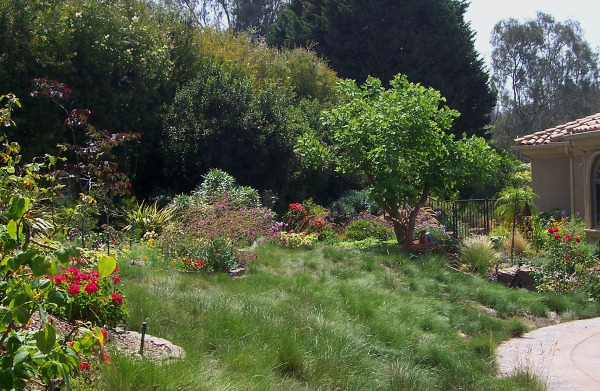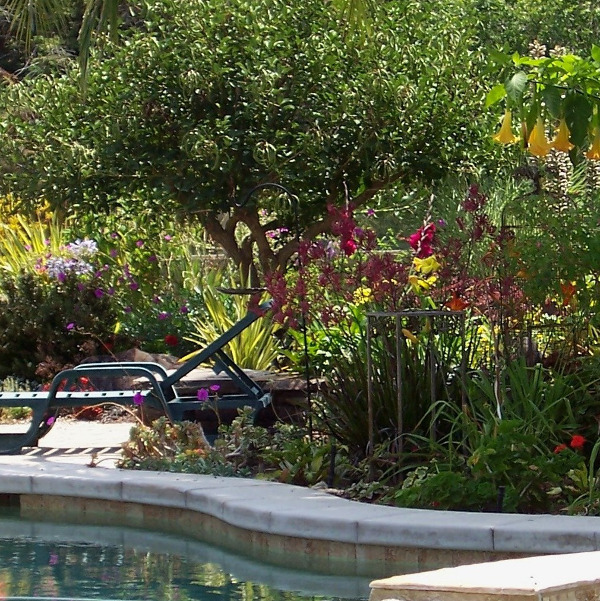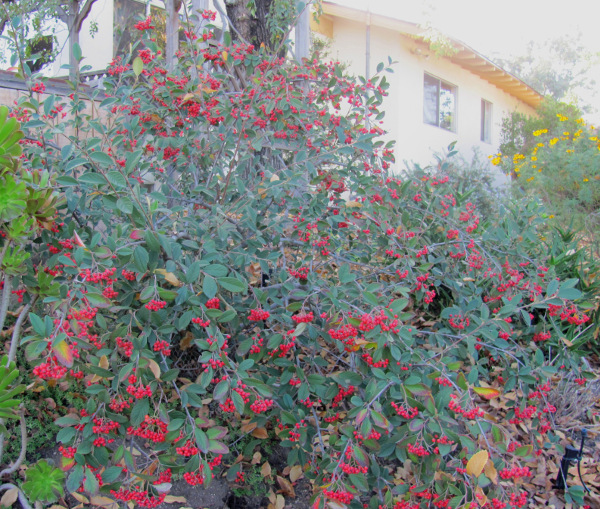
Shrubs hide the boundaries of this garden
For me as a landscape designer placing shrubs in a design is as natural as adding sweetener to my desserts; I’m so sure of their benefits (shrubs, that is) that I never think much about them. However, they have, perhaps the most important place in a home landscape design, and a recent visit at the Water Conservation Garden in El Cajon where many spectacular specimens were in bloom, made me realize how effective shrubs are in any landscape, and so I thought I’d investigate their role.

Foundation plantings can easily take on a very static look
Foundation Plantings
We all know the old standards in our traditional gardens, the Indian Hawthorns or Mock Oranges placed along the base of houses and therefore called “foundation” shrubs. Those gardeners practicing a more low-water and water-wise landscape style might think of Bird of Paradise, or New Zealand Tea Trees (a bush despite of its name) or perhaps Butterfly Bush; other people who have not yet gotten used to our dry climate prize their favorite (when it’s in bloom), the Lilac or the Hydrangea.
These are mostly large bushes with showy flowers, oftentimes pruned to fit the space… As their place was poorly chosen at planting the homeowner ends up fighting the eternal fight and pruning it into unnatural shapes and blobs. Bothered by these maintenance chores, one might not consider the benefits that these very special plants bring to our gardens nor the amazing multitude of size, texture and form we enjoy here in southern California.
The architectural role of shrubs
The most important aspect perhaps is going to be visible in our ‘slow’ months of July and August: It’s so hot and the sunshine so intense that many plants go into summer rest (“estivation” which is the equivalent of winter dormancy. Our California natives are particularly adept at it). Now even drought resistant plants used to our “Mediterranean” climate because of similar origin (such as Daylilies, Lavender Cotton, Iris and Beard’s Tongue or Pelargonium… ) are done with their first cycle of bloom and go into a waiting period until the night temperatures drop and the days get shorter, in mid September or thereabouts.

A limbed-up Coral tree “knits” the perennials below it together
Accent and cohesion
Now imagine a planter bed filled with these small and mid-sized perennials, even succulents and grasses, and notice how “flat” it looks during these months and how little interest there is in such a planting; all is more or less of the same height and “weight” and nothing provides a resting place for the eyes.
However, add a few bushes in the right places, and all of a sudden the scene comes to life: These taller plants provide an anchor and accent, an organizing feature, one that holds the scene together. And while all other smaller plants can put on a great show and are continuously changing, a well placed shrub can give great strength and permanence to this scene.

‘Gold Sunset’ Pink Breath of Heaven with its spreading, reaching form contrasts with the perennial grasses behind
Organization & structure
Place a well-chosen shrub in the background, perhaps spreading like a sheltering umbrella over your soft perennials, and your planter bed will instantly gain organization and structure. Now add to this colorful berries that persist on the shrub, such as Cotoneaster or Toyon, and the visual interest of this planter bed will last perhaps even into the next spring.

Parney Cotoneaster provides shelter, food for birds, small mammals and insects
Some shrubs serve as providers of food and cover, for birds and insects, and enrich our gardens that way. Shown here is the evergreen, water-wise Parney Cotoneaster.
Please see the upcoming Part 2 of this article in which I explore how to design with shrubs, and give a list of choice shrubs to work with.